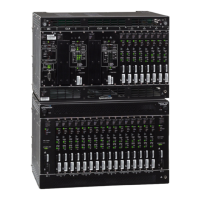097-55501-01 Revision M – January 2009 TimeHub 5500 User’s Guide 107
Chapter 3 Installing the TimeHub 5500
Making Ground and Power Connections
4. At the shelf end of the battery leads, use the multimeter to measure the voltage
between the following test points:
Test Point Test Point Result
Battery A lead Battery B lead 0 V
Battery A lead TB1: Return A 0 V
Battery A lead TB1: Ground 0 V
Battery B lead TB2: Return B 0 V
Battery B lead TB2: Ground 0 V
5. Reconnect the
–48V battery A and battery B leads to the power terminal blocks
(TB1 and TB2)
–48V A and –48V B terminals.
6. Install the A fuse in the power source fuse panel.
7. Measure the voltage between the
–48V A and Return terminals on the TB1
terminal block. The multimeter should indicate –42V dc to –56V dc.
8. Install the B fuse in the power source fuse panel.
9. Measure the voltage between the
–48V B and Return terminals on the TB2
terminal block. The multimeter should indicate –42V dc to –56V dc.
10.Install both 3AG 5 A fuses (fuse A and fuse B) in the front of the shelf. The shelf
is now powered up.
Installing the NTP Server Card
The NTP Server card plugs into one of the output slots labeled A1 through D8 on
the front panel of the TimeHub Master shelf, or slots A1 through H16 on the
Expansion shelf.
1. Align the card edges with the card guides of the selected slot.
2. Slide the card into the shelf until it seats fully into its rear panel edge connector.
3. Slide the appropriate SFP into the upper slot on the front panel until it clicks into
place. The lower slot will be enabled in future releases.
Note: Master shelf CLEI D0MTP0K4RA and above, and expansion
shelf CLEI D0M1X00BRA and above employ 5 Amp fuses (reference
PCN notifications 00783A1 and 00783B1). All shelves prior to this
change are equipped with 10 Amp fuses.
Caution: To avoid possible thermal problems, do not install NTP
Server card pairs in adjacent slots, and do not install more than three
pairs per shelf.

